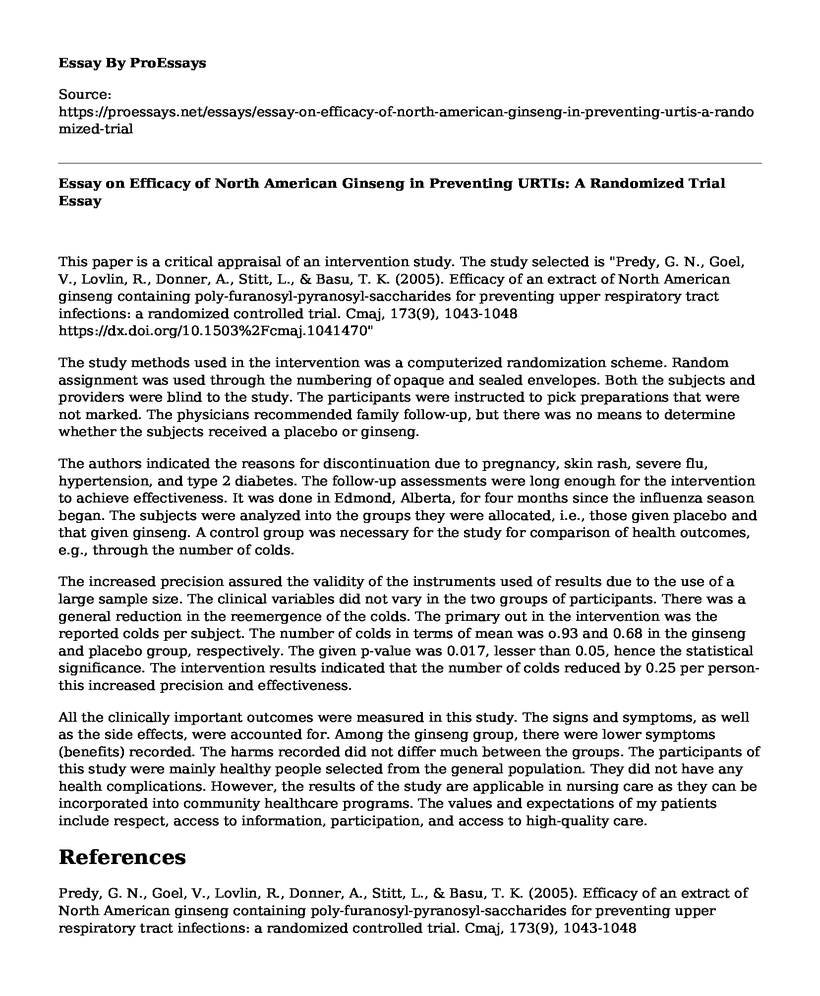This paper is a critical appraisal of an intervention study. The study selected is "Predy, G. N., Goel, V., Lovlin, R., Donner, A., Stitt, L., & Basu, T. K. (2005). Efficacy of an extract of North American ginseng containing poly-furanosyl-pyranosyl-saccharides for preventing upper respiratory tract infections: a randomized controlled trial. Cmaj, 173(9), 1043-1048 https://dx.doi.org/10.1503%2Fcmaj.1041470"
The study methods used in the intervention was a computerized randomization scheme. Random assignment was used through the numbering of opaque and sealed envelopes. Both the subjects and providers were blind to the study. The participants were instructed to pick preparations that were not marked. The physicians recommended family follow-up, but there was no means to determine whether the subjects received a placebo or ginseng.
The authors indicated the reasons for discontinuation due to pregnancy, skin rash, severe flu, hypertension, and type 2 diabetes. The follow-up assessments were long enough for the intervention to achieve effectiveness. It was done in Edmond, Alberta, for four months since the influenza season began. The subjects were analyzed into the groups they were allocated, i.e., those given placebo and that given ginseng. A control group was necessary for the study for comparison of health outcomes, e.g., through the number of colds.
The increased precision assured the validity of the instruments used of results due to the use of a large sample size. The clinical variables did not vary in the two groups of participants. There was a general reduction in the reemergence of the colds. The primary out in the intervention was the reported colds per subject. The number of colds in terms of mean was o.93 and 0.68 in the ginseng and placebo group, respectively. The given p-value was 0.017, lesser than 0.05, hence the statistical significance. The intervention results indicated that the number of colds reduced by 0.25 per person-this increased precision and effectiveness.
All the clinically important outcomes were measured in this study. The signs and symptoms, as well as the side effects, were accounted for. Among the ginseng group, there were lower symptoms (benefits) recorded. The harms recorded did not differ much between the groups. The participants of this study were mainly healthy people selected from the general population. They did not have any health complications. However, the results of the study are applicable in nursing care as they can be incorporated into community healthcare programs. The values and expectations of my patients include respect, access to information, participation, and access to high-quality care.
References
Predy, G. N., Goel, V., Lovlin, R., Donner, A., Stitt, L., & Basu, T. K. (2005). Efficacy of an extract of North American ginseng containing poly-furanosyl-pyranosyl-saccharides for preventing upper respiratory tract infections: a randomized controlled trial. Cmaj, 173(9), 1043-1048 https://dx.doi.org/10.1503%2Fcmaj.1041470
Ohiostatenursing. (2015). Module 4: Critical Appraisal of Evidence (Part 1 of 5). YouTube. https://www.youtube.com/watch?time_continue=1&v=S3Fwfc_rLsY&feature=emb_logo.
Cite this page
Essay on Efficacy of North American Ginseng in Preventing URTIs: A Randomized Trial. (2023, Apr 24). Retrieved from https://proessays.net/essays/essay-on-efficacy-of-north-american-ginseng-in-preventing-urtis-a-randomized-trial
If you are the original author of this essay and no longer wish to have it published on the ProEssays website, please click below to request its removal:
- Essay Sample on Ethical Values in the Practice of Leadership in Nursing
- Essay Sample on Abortion Clinic Access
- Nutrition Care Plan for COPD - Essay Sample
- Management of Disaster Events
- Article Analysis Essay on Health Informatics - E-Health
- The Medical Field & Its Controversies: Abortion & Euthanasia - Essay Sample
- Essay Sample: Safety Concerns for a New Forensic Nurse of a Trauma Patient







